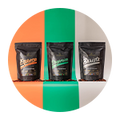Trail running offers an entirely different experience from traditional road running, combining physical demand and mental endurance with the unpredictability and beauty of nature.
Hayden, a passionate trail runner and Beforeyouspeaks man on the ground in New Zealand, shares his journey through the challenges and rewards of this exhilarating sport. In this interview, he opens up about his learnings and close calls, the camaraderie within the trail running community, and the incredible landscapes that make every run an adventure.
Q. What was your first trail run like? Did you know you were signing up for a mud bath and a rollercoaster all rolled into one?
Hayden: Trail run terrain varies from hard pack trails to mud baths, and everything in between. Large amounts of mud aren’t that common, unless you specifically want that kind of race. What you quickly realise on your first trail run is how humbling it can be, whatever pace you run on the road goes out the window pretty quickly! Even hard pack trails are slower than the road.
Then you throw in more elevation (way more elevation!), steeper gradients, constant ups and downs, changes in terrain, some of it technical, it makes for a slower time. But once you settle into the groove it’s super rewarding. Instead of the concrete world most of us live in, you’re out in nature winding through beautiful scenery. Breathing in fresh air and hearing birdsong. It’s magic.
Q. Trail running has been described as '4wding on foot'—how accurate is that? What makes it so much harder than running on the road?
Hayden: It’s not so much that it’s harder, but it is slower and has more variables you need to be prepared for. 4wding on foot is a good analogy! Firstly, you want a decent pair of trail running shoes with good grip. Secondly, you need to be prepared for the elements and from being away from civilisation. A hydration pack with some extra snacks and even a warm top in case you sustain an injury and need to keep warm. A spare pair of socks can be good if it’s likely to be very wet.
Q. You’ve tackled some of the toughest terrains—what’s the craziest situation you’ve found yourself in mid-run? Ever had to outrun a landslide or dodge a surprise river crossing?
Hayden: You definitely have to be prepared for the unexpected! This year alone I’ve had three incidents that were unexpected and changed the whole run. The first one, the event organisers had botched the water at one of the aid stations. I had decide whether to wait 20-30 mins for water or take a chance and run on to the next aid station - 7kms away!
The second was when my training was starting to ramp up again, I signed up for what should have been a fairly mild 12km with 260m of elevation. Except the elevation was way off and more than double what was advertised.
The third one, I was participating in another 12km event but decided I wanted to challenge myself mentally and changed my distance in the morning to the 22km run. Already a bit of a stretch for where my training was at, I managed to miss a turn off and ran an additional 1.5km in the wrong direction before realising and turning back. Feeling like a bit of a numpty I ran the return 1.5km faster than I should have. By the 17km mark I was struggling, and with now 8km (instead of 5km) I had to dig deep and just focus on small incremental goals, one marker at a time, one hill at a time, one km at a time. Up one particularly tough hill it was just one step at a time. But I got it done by resetting my goals and focusing on what was ahead of me in bite size chunks.
Q. Trail running seems to attract a special kind of madness—what is it about the community that keeps you coming back? Is it more about the high-fives or the high stakes?
Hayden: Trail running is definitely becoming more mainstream but there is still a bit of quirkiness to it, the people and outfits are generally more colourful too!
Q. When you’re out there on the trail, is it you against the clock, the terrain, or your fellow runners? How do you balance competition with camaraderie?
Hayden: I’m a midpack runner so for me it’s all about challenging myself physically and mentally. Seeing how far and for how long I can push myself. In regards to the other runners it’s less about competition and more about the camaraderie and the shared experience. While others are having a comfortable Sunday morning we’re out hitting the trails. No matter where you finish, there’s a lot of mutual respect.
The nature of trail running means that you will also spend some time walking up the hills. They are just too steep to run efficiently (even the elite runners walk on hills). This is an easy time to strike up a conversation with a fellow runner and run together for a bit. In a recent half marathon another runner and I got chatting at the halfway mark and then ran together for the next 10km.
Q. How does the mindset needed for trail running compare to road running? Do you feel like you’re conquering a mountain both physically and mentally?
Hayden:
Training
Road running is pretty straightforward. You know what you are going to get, hard and fast services. If you have a phone with you, you can solve 99% of problems you might encounter. Challenges like needing more water or fuel, needing to contact someone or to use maps to work out how to get home are easily solved.
With trail running there are more variables. You don’t know what you are going to get until you get out there. Even tracks you run regularly can change significantly after rain. You want to be more prepared with a hydration pack and some food at the very least. With uneven and technical tracks the risk of injury is higher so you need to plan for that too. Tell someone where you have gone, and carry a phone with you and hope it gets service!
Events
Road running events are also very straightforward. Roads are hard and fast with gentle inclines and declines, and the aid stations are frequent. For a road half marathon l will run at three different paces over the course of the run. The first 5-6 k’s I’ll run a little slower than race pace to warm up and see how I’m feeling. For the next 10 k’s I settle into race pace. For the last 5 k’s if I’m feeling good I’ll go for it and give it all I’ve got and will cross the finish line running hard.
Most runners feel really disappointed if they have to walk any part of a road event.
Trail running is a whole different ball game, and a number of events have big hills right at the start. The ego tells you to run up it with everyone else (“we shouldn’t be walking this early!”) but you have to park the ego and stick to your plan - for me that is generally run the flats and downs, walk the ups. In some events you can find a lot of time walking at the start as all the climbs are early on. It can be a bit soul crushing to be 45-60 minutes into an event and feel like you’ve barely made much progress.
Unless you’ve run the trail before you also don’t know how hard or how easy certain sections will be until you are out there. What looks like an okay section on the (woefully inadequate) elevation profile map can turn out to be a real killer. It can go the other way too, what looks like a tough section can end up being a highlight of the run.
Q. You’ve seen some breathtaking scenery on your runs—what’s the most beautiful, and does it make the challenging terrain worth it?
Hayden: The scenery is definitely one of the joys of trail running. I’ve been fortunate to run so many incredibly beautiful and memorable courses. If I was forced to choose one I would say, The Dual. It runs across two islands linked by a causeway in Auckland’s Hauraki Gulf. One island, Motutapu, is green,lush and steep, the other, Rangitoto, is a 600-year old dormant volcano that is so present on the Auckland landscape. No matter where you turned, or what hill you came over you were treated to stunning views of the Gulf, islands, beaches, bush and Auckland city.
Q. What’s been your toughest trail run yet? Was there a moment when you thought, ‘What on earth am I doing here?’
Hayden: The toughest one yet was probably the Hobbiton Halfling Marathon. It was on farmland so a lot of sloped and rutted terrain, aka hard work and constant ankle injury risk! There was a 7m jump into a watering hole, and then a never ending climb up an incredibly steep hill. It also had Hobbiton village, an on-the-run drink at The Green Dragon Inn, and men on horseback. It was both brutal and exhilarating. A truly epic journey!
Q. Switching from trail runs to road runs must be a shock to the system—how do you train differently for each? And which one do you secretly enjoy more?
Hayden: As much as I would love to train on trails regularly, most of my training is road running. It’s just more convenient to step straight out of the door and run than drive to a trail and run. The irony! I love them both, I just love trail running more.
Q. Trail running is as much a mental challenge as it is a physical one—how does being in top physical shape support your mental game? Does the grind ever clear your head or is it a test of endurance in more ways than one?
Hayden: As humans we are made to move, I firmly believe that the physical leads the mental.
Let’s be honest, running isn’t easy. It can be really hard to get started, but you always get more upside from a run than downside. Whether that's some ‘me time’, active meditation, thinking time, improved fitness or the glow afterwards. You’re also building your mental resilience. You are learning to persevere and endure.
When I was training for my first half marathon one of the most important runs I did was an 8km hill run. On the day it was scheduled it was pouring down - really pouring down! I threw on a jacket and headed out, within 500m my shoes were saturated but I ran the full 8km and didn’t shy away from the hills or the rain. After that run, I knew I mentally had what I needed to get through the 21km on event day.
Q. Balancing a passion like trail running with work and family must be tricky—how do you make it work? Any tips for finding time to run when you’ve got a full plate at home?
Hayden: As I’ve gotten older, I’ve realised a few important things about my health and fitness that I didn’t need to think about when I was younger.
Firstly, consistency and balance are the key as we age. Instead of 3-4 sessions a week, I now focus on 5-6 smaller sessions a week. An ideal week will be three runs (an easy run, a faster/workout run, and a longer run) plus three weight sessions. The strength sessions are focused on functional strength and stability, so lots of compound movements using lower and moderate weights. While I may not feel as strong as when I lift heavy, my body works way better. It also allows me to run consistently and I love the feeling of being fit. My wife, Maria, and I generally try to do the workouts together in our garage using dumbbells, kettlebells and a pull up/upward row bar down the side of the house. It’s nice time spent together as well as improving our health.
Secondly, you have to make time. Often that means getting up earlier to get that run in, but it’s so worth it. To be 6k’s into a run and really getting into the flow while the sun is rising makes you feel very alive. I currently run with a group on Thursday mornings at 6am, I always hate the thought of getting up early but it’s always one of my favourite days of the week. The glow lasts all day.
Thirdly, to be my best for work and family I need to be at MY best. Too often we give up our own needs for work and family, but you’ll be able to give them more if you look after yourself first.
Q. Lastly, how do you recover from these gruelling runs? Do you have any go-to rituals, or is it just about getting back out there as soon as possible?
Hayden: As soon as I finish an event run I naturally want hydration and carbs. I don’t want protein at that stage but I try to force down a protein bar. My next focus is on recovery - cooling overheated muscles to reduce inflammation. If the run is near the sea or a lake I’ll go and stand in the water for 10-20 minutes to cool down making sure my legs and lower back are submerged. It also helps wash away the dirt and grime! Otherwise I have an ice bath at home in the bathtub.
That evening I have a protein and nutrient rich meal, I’m craving it by now! In regards to getting back into it, it might sound like a cliché but I listen to my body. Sometimes I’ll go a week or more with nothing more than walking, other times I’ll do a light workout or light run 2-3 days after the event.










